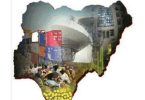The following 10 countries qualify for the most troubled and most dangerous countries in the world. Compiled reports as of October 2023 using the Global Peace index (GPI) scores on the Institute of Economics and Peace website have continued to confirm it. Out of a total of 163 countries, these countries have emerged as places definitely not suitable for a luxury ride, or a tourist visit.


There is absolutely no point asking any of their citizens what life looks like on a daily basis. It is predictably a battle for survival, with nothing to guarantee their safety or quality of life. And with many scars and sour memories to show for it.
About the Global Peace Index
The online Independent newspaper declared in a 2023 report that:
‘Peace across the world has declined to the lowest level in 15 years, as uncertainty over post-COVID economic recovery and Russia’s war in Ukraine loom large‘.
Not only that, since the inception of the Global Peace Index ratings in 2008, 77 countries improved and 84 countries dropped down the ladder. Again, the GPI has fallen a further 0.42% in the year 2023.
Permit me to take you on a virtual tour of the top 10 dangerous countries in the world to avoid right now. Purely for your own safety and peace of mind.
Afghanistan
Yet again, Afghanistan has emerged the number 1 danger capital of the world. For the sixth time running, the country is at the peak of the most dangerous countries in the world. You should not be caught wandering aimlessly in this country for sure.
The Taliban, a Sunni Islamist group, controlled most parts of the country from 1996 till 2001. By 2001 they were ousted by US troops. Sadly, the Taliban waged war against the US-backed government and seized the nation’s capital, Kabul in 2021 for the second time. And with their return came innumerable woes.
Also Read- Top 10 Largest Countries in the World
The extremist imposition of the Sharia law by the Taliban saw them cracking down on the Press, as well as civil rights groups. Also, the fundamental human rights of women and girls were badly trampled upon. So much that females could no longer go to work, nor have access to basic healthcare or education.
Widespread violence continued – as the Taliban security forces continued to arrest, torture and kill several persons deemed enemies of their government. These include Shi’a muslims, activists, and supporters of the Islamic State of Khorasan Province.
The country is currently facing a whole lot of international sanctions and restrictions. Malnutrition and poverty is at an all-time high, and the country is hard-hit by inflation and scarcity of food. Afghanistan government and humanitarian agencies have also been cut off from international donors.
Yemen
Yemen is also hard-hit by a serious humanitarian crisis. And more so following 8 years of internal conflict, in spite of a brief truce that lasted from April to October 2022. Indeed the violence has not stopped altogether; and fallouts from the war continue to affect its citizens.
The number of internally displaced persons in Yemen is an estimated 4.5 million persons between 2015 and 2018. Cost of food and other essentials have soared. Coupled with the impact of extreme weather conditions, and the effect of Explosive Remnants of War (ERW) such as landmines on free movement. It has been a tale of sorrow for most Yemeni civilians. Women and children make up more than three-quarters of displaced persons in Yemen.
To make matters worse, the Yemeni authorities have continued to impose serious restrictions on access to humanitarian assistance by people in dire need. These restrictions have even devolved into kidnappings, car hijacking, and unlawful detention of humanitarian personnel.
Syria
Hafez al-Assad, the then-president of Syria died in 2000, and his son Bashar took over power. For the next 11 years, Syrians witnessed a deteriorating quality of life. There was widespread corruption, repression by the government, and rising unemployment. The the citizens came out on a peaceful protest against government tyranny in March 2011. Unfortunately, Bashar Al-Assad mandated his security forces to go all out to crush the dissidents.
This excessive use of force quickly led to nationwide protests calling for Bashar’s resignation. As such, the protesters took up arms to wage war against Bashad’s security agents. In a short while, the events escalated into a full scale civil war that lasted another 11 years. The war also saw armed rebels and jihadists joining forces for and against the government, with terrible consequences on the citizens.
More than half a million Syrians have died ever since the war began. The deaths included those directly impacted by the war; and those who were victims of arrest and torture by the government.
About 6.9 million persons have been internally displaced. And another 6.8 million citizens are refugees in other countries such as Jordan, Lebanon and Turkey. The host countries can no longer cope with the situation. And it has compelled the likes of Turkey to insist on the Syrian refugees returning back home. The situation was further worsened with the recent earthquakes that hit both Syria and Turkey in February 2023.
The poverty rate in Syria now stands at about 90%. Malnutrition, food shortage, inflation, US sanctions, and the after-effects of COVID-19 have crippled the economy. Furthermore, most of the public infrastructure and heritage sites have been destroyed.
South Sudan
The whole region of Sudan and South Sudan had been embroiled in wars and crises for decades. Even though South Sudan gained its independence in 2011, it was not yet salvation time.
South Sudan currently faces a huge refugee crisis, the worst of its kind in Africa. Well over 2.3 million South Sudanese people are refugees in neighboring nations. Another 1.87 million citizens are internally displaced. This was the fallout of almost ten years of civil war that erupted in 2013. The president at that time, Salva Kiir Mayardit accused then-Vice President, Riek Machar of an attempt to overthrow him. The resulting chaos pitted ethnic groups against each other, and government forces against rebel groups.
Also, the crude oil-rich South Sudan had its oil refineries destroyed during the war and subsequently, national oil production was shut down. The country lost almost 98% of its earnings, and the economy took a downturn. Climate change also affected food supply, and famine ensued. So many schools were also destroyed in the conflict. It resulted in about half of the population of children in South Sudan having no access to education. Far more girls than boys were particularly affected.
DR Congo
The Democratic Republic of Congo (DRC) today is one of the five poorest nations on the Earth despite its large size. Ironically, the DRC is hugely blessed with natural resources and arable land. However, the political upheavals and bad governance of many years have not allowed citizens of the DRC to enjoy anything significant. There are more than 5 million internally displaced persons, and more than 1 million refugees from the DRC in neighboring countries.
The first and second Congo wars occurred as a result of armed ethnic Hutus escaping from the genocide in Rwanda to neighbouring nations. The armed groups resorted to fighting the natives of the DRC and war broke out. Furthermore, the trade in natural resources further fueled the war; prompting the US to outlaw buying of those minerals from the DRC. Many multinational companies were compelled to abandon any subsequent trade in minerals with the DRC because of difficulty in obtaining certification. As such, so many miners were thrown out of work.
Furthermore, innumerable citizens of the DRC have been continually subjected to human rights abuses by more than 100 rebel groups. The country as of today is marked by extreme poverty and acute food shortage.
Russia
Russia has had a long history of wars. First it was the Mongol invasion of the 13th Century. Then the Napoleon-led French invasion of 1812; followed by Germany’s Hitler in World War II. Russia has over the years become heavily militarized out of necessity. Now for the second significant time in its history, Russia is justifying an offensive war – this time against Ukraine. (There was one such war against Kazan, a successor of the ancient Mongol empire in 1552).
The reason? Russia claims Ukraine needs to be “demilitarized and de-nazified”. This was following supposed reports that some kind of genocide was taking place against Russian speakers in Kyiv, the capital of Ukraine. The allegations are largely not substantiated, as even Russian citizens are at peace with the Ukrainians.
Before now, Russia and Ukraine had been involved in armed conflict over the annexation of Crimea to Russia (since 2014). Crimea is a peninsula on the eastern part of Ukraine. Thus, there were strong allegations against Russian President Vladimir Putin. That he may very well be attempting to reclaim the lost, independent countries of the former Soviet Union (of which Ukraine was a part).
The Russia-Ukraine war has led to an economic and humanitarian crisis in Ukraine. At least 5.5 million Ukrainians have been displaced from their homes, and over 8 million of them resorted to fleeing to other countries. Over 40,000 civilian Ukrainians, and over 100,000 Ukrainian soldiers have also been killed. On the Russian side, there have been forced proscriptions of men to join the war. Over 80,000 Russians are estimated to have died since the war started, with huge attendant losses in military equipment.
Widespread economic sanctions were imposed on Russia by the USA, UK, the European Union, and many other countries. And the Russian economy is currently facing a recession. Going further, the war has spilled over to affect the entire globe. Both Russia and Ukraine were major exporters of corn, wheat, barley and cooking oil to places such as Africa and the Middle East. Russia was also a global supplier of crude oil and fertilizer.
The war has truncated global supplies of these essential commodities, thus heightening inflation and food shortage in many countries. In addition, Russia made itself an impediment in the supply of Ukrainian grain across the Black Sea ports.
Ukraine
Ukraine is the second largest country in Europe after Russia; and they both share borders. Ukraine has never truly enjoyed self-rule. It was occupied by Slavic people, and ruled by the Kievan Rus sometime around the 9th Century. The region separated into competing regional powers that were ultimately crushed by the invading Mongols in the 13th Century. Over the next 600 years, the region was ruled by Polish-Lithuanian, Ottoman, Austrian, and Russian empires one after the other.
In the 17th Century however, a Cossack Hetmanate arose in Central Ukraine (which could not uphold itself). Meanwhile, the land was subsequently divided between Russia and Poland, and thereafter taken over by the Russian Empire. But in 1917, the Russian Revolution led to the establishment of the Ukrainian People’s Republic. Yet again, the Bolsheviks moved to reinforce their control over the larger portion of the former Russian empire. Thus they created the Ukrainian Soviet Socialist Republic (which became a part of the Soviet Union in 1922).
There was a devastating famine in Ukraine in the early 1930s. And unfortunately, the World War 2 arrived soon after, bringing along with it the invasion of Ukraine by German forces. About 7 million Ukrainian civilians (including most Ukrainian Jews) were killed in the war.
When the Soviet Union disintegrated in 1991, Ukraine gained its independence. Following this, the country adopted a new constitution in 1996. But massive demonstrations and a revolution led to the creation of a new government in 2014. Yet again, Russia pounced on the fragile country, by annexing Ukraine’s Crimean Peninsula to itself. It unavoidably led to a war between government forces in Eastern Ukraine, and separatists supported by the Russian government. And in 2022, Russia embarked on a full-scale attack on, and invasion of Ukraine. The renewed hostilities between Russia and Ukraine has encouraged Ukraine to forge stronger bonds with the European Union, NATO, and the United States.
Ukraine is the poorest country in Europe (in terms of Gross Domestic Product per Capita). The country is also facing issues of corruption and mismanagement in government circles. However, the country has large portions of fertile land; and was the largest exporter of grain in the world before the Russian-Ukraine war. The current war has further undermined the much-needed peace and socioeconomic development of Ukrainian citizens, following centuries of crisis. It has also badly tampered with the supply of wheat and other grains across the world. This singular war has had a huge impact on global food supplies, and contributed to rising cases of famine worldwide.
Somalia
Somalia is besieged with problems stemming from internal conflicts that arose from the prolonged Somali civil war, which started in 1988. The war was a face-off between the ruling Somali armed forces (led by Siad Barre) and several rebel groups. The United Nations peace-keeping forces intervened between 1992 and 1995; but withdrew due to a large number of human losses.
Furthermore, the economic and social landscape of the fragile nation has been seriously battered. These are direct results of drought (and the resultant famine); a large number of internally-displaced persons, child labor, gender-based violence, and early marriages. As of the end of 2022, more than 836,000 Somali refugees and asylum seekers have fled to other countries. And nearly 3 million people are internally displaced across Somalia. Ironically, Somalia is also host to more than 33,600 refugees and asylum seekers from neighboring countries.
Sudan
Sudan is the largest African nation in terms of size. Unfortunately, it has been plagued by wars right from its independence from Britain in 1956. The North and South of Sudan had serious disagreements that led to a civil war soon after independence. Even worse, a military coup took place twice in 1958 and 1969.
There was a brief truce in 1972 between the government and southern rebel groups, as they were made to sign a peace agreement. Unfortunately the civil war resumed in 1983. Because the Muslim-dominated North and the military government, attempted to impose Sharia law on the whole of Sudan. Meanwhile, the South Sudan population comprises a large number of Christians and traditionalists.
An attempt to bring the government and rebel forces to an agreement in 1989 was cut short. Omar al-Bashir, a military extremist leader, forcefully took over power in that year. Another attempt to end the civil war through negotiations in 2003 was stopped, when rebel groups attacked military installations in Darfur. The Sudanese Liberation Army was the principal rebel faction in the latest attack.
In all, Sudanese civilians have known no peace. The military government has also been accused of hiring Janjaweed fighters from the North to attack villages (believed to be harbouring rebel fighters). As a result, over 4 million people have been displaced, and roughly 2 million people have died since 1983. More than 200,000 Sudanese refugees are harboured in Chad republic.
Sudan is known to have large deposits of gold and crude oil. The land is also a mix of arable and desert areas, allowing for the cultivation of peanuts and cotton. It is well known that the country’s oil revenue constituted about 73% of total export earnings. Nevertheless, Sudan remains one of the poorest nations in the world. The oil facilities have also been a prime target of the rebel forces.
Iraq
Right from World War 1 till 2019, Iraq was a hotbed of wars. The country became a target of multiple assailants, both from within itself and from external forces. Religious and political power struggles (both within the region and globally) seemed to have fuelled the unending upheavals in Iraq. Over 1 million persons have been internally displaced due to attacks by muslim extremists (the ISIS).
In 2003, a coalition of fighters led by the US invaded Iraq and conquered the then-president, Saddam Hussein. The reason being that Saddam Hussein was seen by the USA and UK as a regional and global threat to security. Saddam Hussein threatened to use nuclear weapons (and other weapons of mass destruction), which was not acceptable. Hussein was also accused of extreme human rights abuses; violent invasion of Kuwait; and a protracted war against Iran. Also, his repression of Iraqi citizens rose to the tune of almost 290,000 deaths.
After the fall of Hussein, there was a power vacuum that could not be filled by the USA or the coalition forces. The US military forces were also accused of a number of human rights abuses, and were subsequently being targeted by insurgents. Thus, the US forces withdrew in 2011 following the extremist group, Al-Qaeda bombing of the al-Askari mosque. The bombing pitted the Shi’a muslims against the Sunnis (the Shi’a muslims own the al-Askia mosque).
A return of the US government occured in 2014 in an intervention move to assist the government. However, the unending insurgency continues till this day, as well as the Shi’a-Sunni conflict. This was in spite of peaceful demonstrations that took place in 2019, which led to formation of a new government in 2020.
Iraq is embroiled in an economic crisis as we speak. The country is blessed with crude oil (which makes up over 99% of its foreign exchange earnings). However, its refineries are not working. The country is also plagued with security problems, lack of basic infrastructure, high unemployment rate (almost 70%), and widespread corruption.








